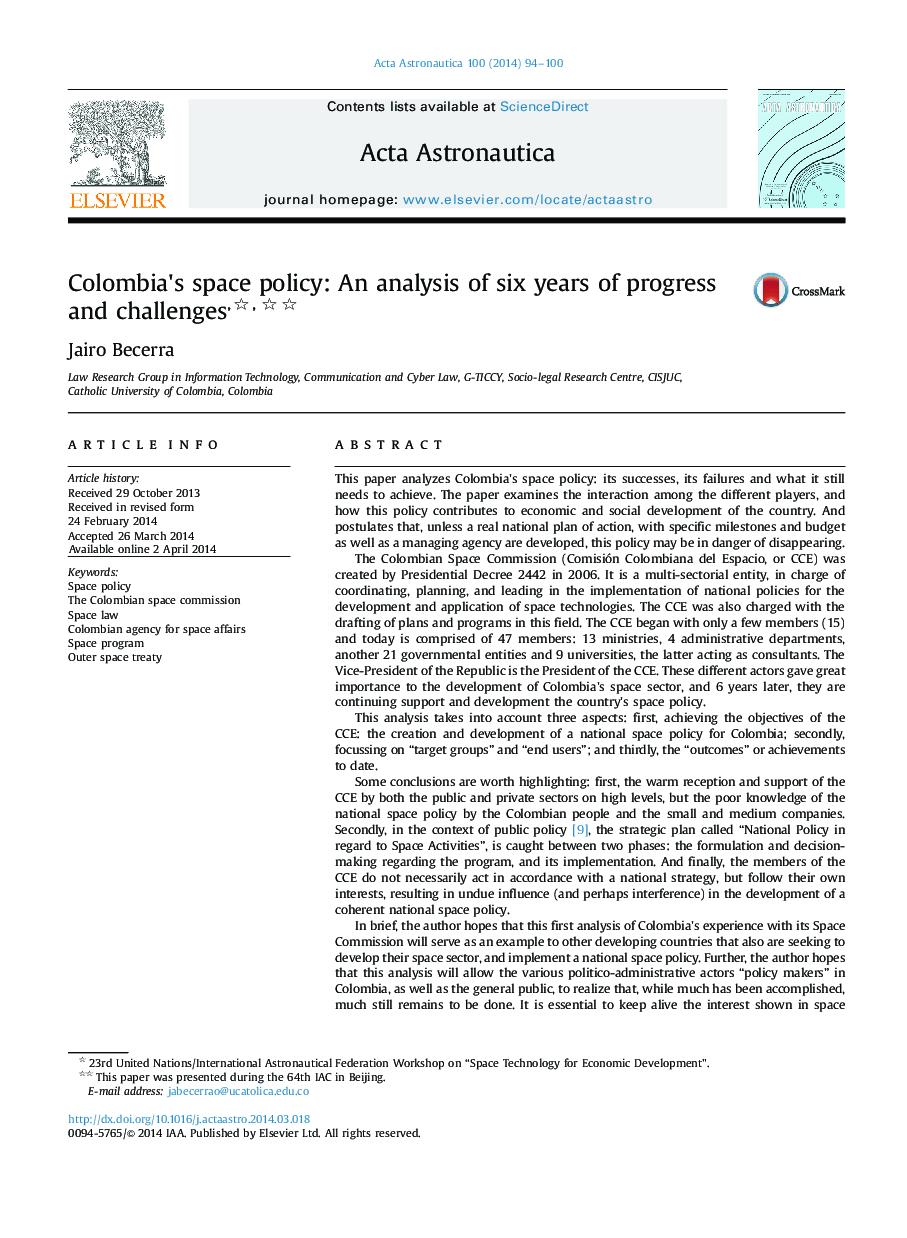| کد مقاله | کد نشریه | سال انتشار | مقاله انگلیسی | نسخه تمام متن |
|---|---|---|---|---|
| 1714542 | 1519952 | 2014 | 7 صفحه PDF | دانلود رایگان |
• We could say that Colombia has a space policy though it is not clear or unified.
• The Colombian Space Policy (CSP) is at risk of suffering a paralysis.
• The CSP is between the third and fourth phases of the policy cycle.
• The members of the CCE do not necessarily act on the basis of a national strategy.
• An autonomous budget to conduct space activities in Colombia is required.
This paper analyzes Colombia׳s space policy: its successes, its failures and what it still needs to achieve. The paper examines the interaction among the different players, and how this policy contributes to economic and social development of the country. And postulates that, unless a real national plan of action, with specific milestones and budget as well as a managing agency are developed, this policy may be in danger of disappearing.The Colombian Space Commission (Comisión Colombiana del Espacio, or CCE) was created by Presidential Decree 2442 in 2006. It is a multi-sectorial entity, in charge of coordinating, planning, and leading in the implementation of national policies for the development and application of space technologies. The CCE was also charged with the drafting of plans and programs in this field. The CCE began with only a few members (15) and today is comprised of 47 members: 13 ministries, 4 administrative departments, another 21 governmental entities and 9 universities, the latter acting as consultants. The Vice-President of the Republic is the President of the CCE. These different actors gave great importance to the development of Colombia׳s space sector, and 6 years later, they are continuing support and development the country׳s space policy.This analysis takes into account three aspects: first, achieving the objectives of the CCE: the creation and development of a national space policy for Colombia; secondly, focussing on “target groups” and “end users”; and thirdly, the “outcomes” or achievements to date.Some conclusions are worth highlighting: first, the warm reception and support of the CCE by both the public and private sectors on high levels, but the poor knowledge of the national space policy by the Colombian people and the small and medium companies. Secondly, in the context of public policy [9], the strategic plan called “National Policy in regard to Space Activities”, is caught between two phases: the formulation and decision-making regarding the program, and its implementation. And finally, the members of the CCE do not necessarily act in accordance with a national strategy, but follow their own interests, resulting in undue influence (and perhaps interference) in the development of a coherent national space policy.In brief, the author hopes that this first analysis of Colombia׳s experience with its Space Commission will serve as an example to other developing countries that also are seeking to develop their space sector, and implement a national space policy. Further, the author hopes that this analysis will allow the various politico-administrative actors “policy makers” in Colombia, as well as the general public, to realize that, while much has been accomplished, much still remains to be done. It is essential to keep alive the interest shown in space activities; otherwise, Colombia׳s space policy may become an “endangered species”, in danger of failing and disappearing.
Journal: Acta Astronautica - Volume 100, July–August 2014, Pages 94–100
